一、前言
在程序中,有很多高效率的字符串处理方式,如果开发者能够完全掌握这些高效的字符串处理,往往在开发者也能事半功倍。比如针对于字符串的处理,也是自然语言处理的基础知识。
而python3中,处理字符串的库为:string。本篇将详细介绍各种字符串的高效处理方式。
二、首字母大写
对于英文单词组成的字符串来说,很多时候,我们需要对英文的首字母进行大写的变更。如果没有了解其高效率的函数,一般我们都通过循环,判断空格,取空格后一位的字母,判断其在ASCII中的编码后,取其大写替换掉该位置的字符串。
但是,python3中有一个函数可以直接将首字母大写,该函数为capwords()。下面,我们来通过一小段代码实现首字母大写的字符串变更。
import string
s = "When he shewed the riches of his glorious kingdom and the honour of his excellent majesty many days, even an hundred and fourscore days"
print("原始字符串")
print(s)
result = string.capwords(s)
print("首字母大写字符串")
print(result)
运行之后,我们会得到全大写首字母字符串:

三、字符串模板
在string库中,字符串模板函数为string.Template(),它可以用来拼接字符串。示例代码如下:
import string
values = {
"name": "liyuanjing",
"age": "13",
}
s = """My name is : $name
I am $age years old
"""
template_str = string.Template(s)
print(template_str.substitute(values))
这里,我们使用字符串模板string.Template,然后通过函数substitute()进行字符串替换。

不过,这里有可能替换时values字典中没有对应的key怎么办?string库还给我们提供了一个函数safe_substitute()。
import string
values = {
"name": "liyuanjing",
"age": "13",
}
s = """My name is : $name
I am $age years old
$work
"""
template_str = string.Template(s)
print(template_str.safe_substitute(values))
因为字典没有对应的值进行替换,所以会保留原始的字符串数据。效果如下:
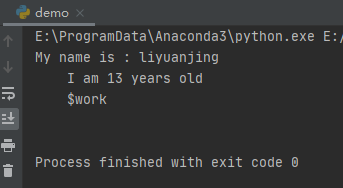
四、高级模板
上面的模板使用方法是string库默认提供的规则体系。其实,我们还可以自定义模板的使用匹配方法,具体代码如下:
import string
class MyTemplate(string.Template):
delimiter = '@'
idpattern = '[a-z]+_[0-9]+'
values = {
"name_1": "liyuanjing",
"age_1": "13",
}
s = """My name is : @name_1
I am @age_1 years old
@work_1
"""
template_str = MyTemplate(s)
print(template_str.safe_substitute(values))
这里,delimiter代表需要匹配的符号,默认符号"$",博主替换成了‘@'。其次,idpattern是values对应的key名字规则,这里用正则表达式规定,比如是"字符串_数字"。运行之后,效果如下:
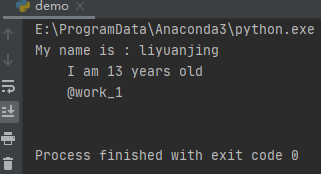
五、format用法
基本用法
有过其他语言基础的都应该或多或少接触过format字符串替换。这里,我们直接来看看其基本的使用方式:
print("My name is {}".format("liyuanjing"))#大括号匹配,按顺序依次填充
print("My {1} is {0}".format("liyuanjing","name"))#数字匹配,按位置依次填充
print("My {name} is {tom}".format(tom="liyuanjing",name="name"))#关键字匹配,按关键字填充
运行之后,效果如下:
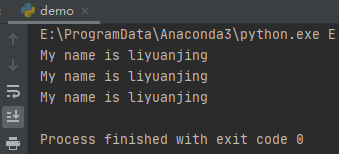
六、进阶用法
format函数不仅可以匹配替换字符串,还可以通过它对其文本,或者取小数某几位等等。下面,我们来看看这些用法如何实现。
print('{} and {}'.format('tom', 'Jerry'))
print('{:10s}'.format('*')) # 默认左对齐
print('{:>10s}'.format('*')) # 右对齐
print('{:^10s}'.format('*')) # 中间对齐
print('{:<10s}'.format('*')) # 左对齐
print('{} is {:.2f}'.format(3.411592653, 3.1415926))#取2位小数
values = {
"name_1": "liyuanjing",
"age_1": "13",
}
s = """My name is : {name_1}
I am {age_1} years old
"""
print(s.format(**values))
注释已经非常详细,这里不在赘述。效果如下:
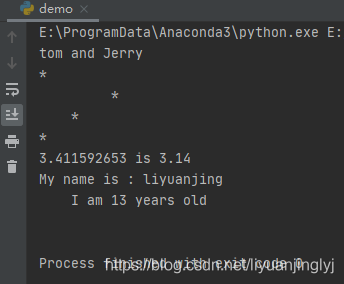
七、高阶用法
format除了能做上面这些事情之外,还可以转换进制以及ASCII码符号等等。下面,我们来实现这些高阶用法。
print('{:b}'.format(8))#:b转换为二进制
print('{:c}'.format(200))#:c转换Unicode字符串
print('{:d}'.format(111))#:d转换十进制
print('{:o}'.format(8))#:o转换八进制
print('{:x}'.format(32))#:x转换十六进制
print('{:e}'.format(32))#:e转换幂符号
print('{:%}'.format(0.32))#:%转换百分值
print('{:n}'.format(32000000000))#:n就是数值
print('{:g}'.format(32000000000))#:n也是数值,不过特别大时转换为幂科学计数
运行之后,效果如下:
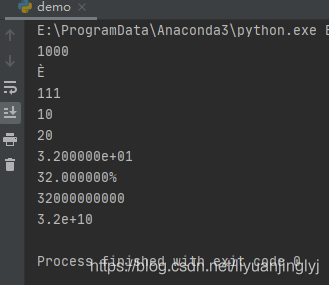
js








